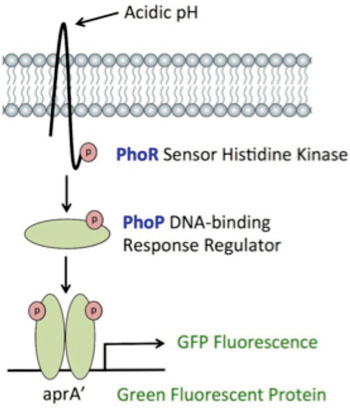Modifying the Macrophage Microenvironment Reduces Tuberculosis Virulence
By LabMedica International staff writers
Posted on 06 Aug 2015
The virulence of the bacteria causing latent tuberculosis infections can be reduced by modifying the microenvironment inside the macrophages that host the pathogen.Posted on 06 Aug 2015
Mycobacterium tuberculosis must sense and adapt to host environmental cues to establish and maintain an infection. The two-component regulatory system PhoPR plays a central role in sensing and responding to acidic pH within the macrophage and is required for M. tuberculosis intracellular replication and growth in vivo. Therefore, the isolation of compounds that inhibit PhoPR-dependent adaptation may pave the way for development of new therapies to treat tuberculosis.

Image: Mycobacterium tuberculosis (Mtb) uses environmental pH as a cue to adapt its physiology for survival in macrophages. The phoPR two-component regulatory system functions to sense environmental pH and promote Mtb pathogenesis (Photo courtesy of Michigan State University).
Investigators at Michigan State University (East Lansing, USA) screened more than 273,000 different compounds while searching for those that could attenuate or eradicate M. tuberculosis.
They identified the carbonic anhydrase inhibitor ethoxzolamide as being able to modify PhoPR regulation and reduce virulence of the tuberculosis bacterium. Ethoxzolamide binds and inhibits carbonic anhydrase, which plays an essential role in facilitating the transport of carbon dioxide and protons in the intracellular space, across biological membranes and in the layers of the extracellular space. The primary function of the enzyme in animals is to interconvert carbon dioxide and bicarbonate to maintain acid-base balance in blood and other tissues, and to help transport carbon dioxide out of tissues. The inhibition of this enzyme affects the balance of applicable membrane equilibrium systems. Carbonic anhydrase inhibitors are primarily used for the treatment of glaucoma. They may also be used to treat seizure disorder and acute mountain sickness. Because they encourage solubilization and excretion of uric acid, they can be used in the treatment of gout.
The investigators reported in the August 2015 issue of the journal Antimicrobial Agents and Chemotherapy that by employing quantitative single-cell imaging of a PhoPR-dependent fluorescent reporter M. tuberculosis strain, they were able to demonstrate that ethoxzolamide inhibited PhoPR-regulated genes in infected macrophages and mouse lungs. Moreover, ethoxzolamide reduced M. tuberculosis growth in both macrophages and infected mice.
"The compound we found inhibits TB's ability to detect acidic environments, effectively blindfolding the bacterium so it cannot resist the immune system's assault," said senior author Dr. Robert Abramovitch, assistant professor of microbiology at Michigan State University. "Basically, ethoxzolamide stops TB from deploying its weapons...shutting down its ability to grow inside certain white blood cells in the immune system. We found the compound reduces disease symptoms in mice."
"The single biggest reason for the evolution of drug-resistant strains is the long course of treatment," said Dr. Abramovitch. "It is difficult for a patient to complete the entire antibiotic course required to kill all of the bacteria. Shortening the duration will help slow the development of these resistant strains. We do not necessarily have to find drugs that kill TB, we just need to find ones that interfere with the bug's ability to sense and resist the immune system. By giving the immune system a helping hand, natural defenses can then kill the bacteria."
Related Links:
Michigan State University














